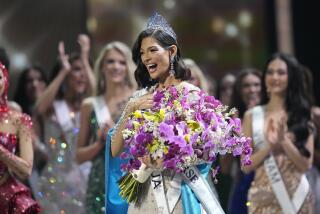A Woman’s Slim Hopes for Survival
MANAGUA, Nicaragua — Marta Garcia got a toothache, and that’s how she found out she had breast cancer.
The dentist noticed bumps on her neck and referred her to a doctor. By the time Garcia’s cancer was diagnosed on Jan. 15, 1997, it had spread from her right breast to other parts of her body.
Despite surgery, radiation and chemotherapy, doctors now say her chances for survival are slim.
“We are just waiting to see where the cancer will reappear,” says Dr. Carlos Vargas, a surgical oncologist.
Late diagnosis of breast cancer is common in Nicaragua and other developing nations, where there is virtually no public education about the disease or early detection programs.
Garcia was one of 65 women diagnosed with breast cancer last year at the state-run Women’s Hospital in Managua, the capital. There are no national statistics on the number of breast cancer diagnoses annually.
Forty-five women died from the disease in 1997, and 58 succumbed to the illness the year before.
Vargas says 70 percent of all breast cancer cases in Nicaragua are diagnosed late--often too late. Of those women whose breast cancer is detected late, three of every four will die within three years. Almost all will be dead within five.
Women have a far better chance of surviving breast cancer in the United States, where only one in 10 cases is detected so late, the National Cancer Institute says.
Unlike most women in the United States, Garcia was never taught to examine her breasts for suspicious lumps until she was in her late 20s. And like most traditionally modest Nicaraguan women, she rarely visited a gynecologist.
As for mammograms, they did not even exist in this impoverished Central American nation until just six years ago. Now they are available only in Managua and Leon, but the screenings are not paid for by government health insurance.
State health care also does not cover radiation treatment or chemotherapy, only surgery. In a country where the average monthly salary for a city dweller is the equivalent of $50 a month, the $2,700 needed to pay for nine chemotherapy sessions is prohibitive.
Garcia, who was laid off from her job last year, was one of a rare few who have had most of the costs of radiation and chemotherapy treatments waived by the government.
Today, Garcia is bald from the effects of cancer therapy. Her right breast is gone, replaced by a dark, ragged scar.
Reconstructive surgery to replace the breast is not an option in Nicaragua, where doctors lack the materials and know-how to undertake the procedure. Protheses for mastectomy patients are not sold in Nicaragua.
“I wasn’t able to look at my chest until three days after the operation,” Garcia says, sitting in the small bedroom with turquoise-painted walls where she was born 38 years before.
She draws strength from her mother, Teresa Garcia, 59, who cared for her after her surgery, and from her husband, Ricardo Martinez, 44.
“This illness has shown me that I am strong,” she says.
Nevertheless, Garcia seems to sense her chances of survival are slim.
“I’m afraid to know,” she admits. “All I care about is getting better. I don’t want to hear predictions about how long I am expected to live.”
More to Read
Sign up for Essential California
The most important California stories and recommendations in your inbox every morning.
You may occasionally receive promotional content from the Los Angeles Times.










